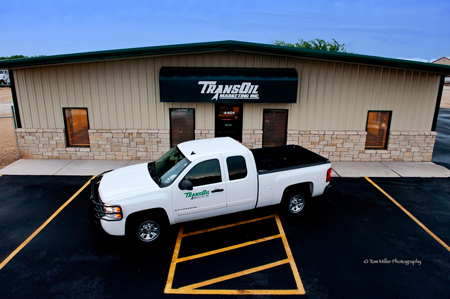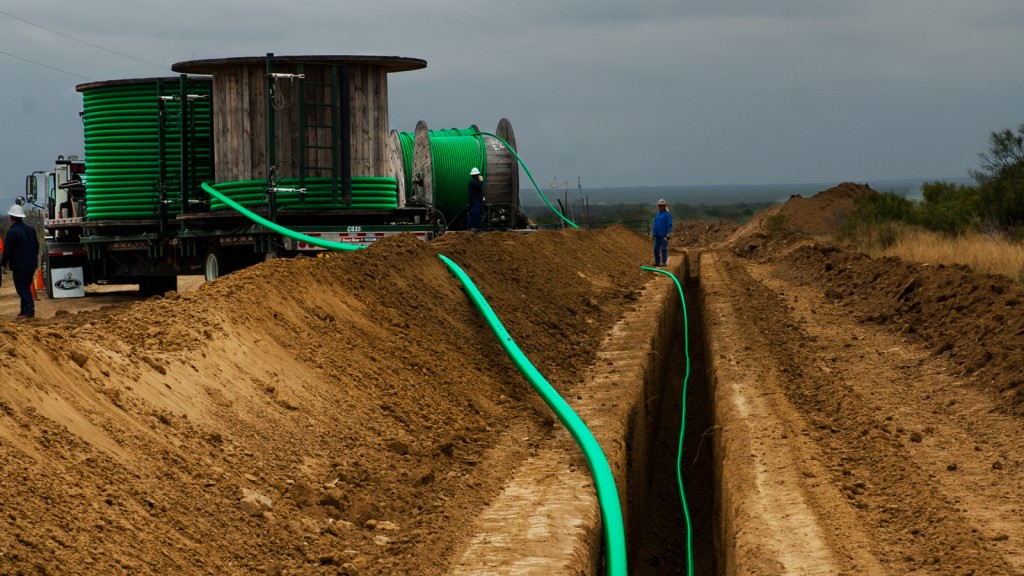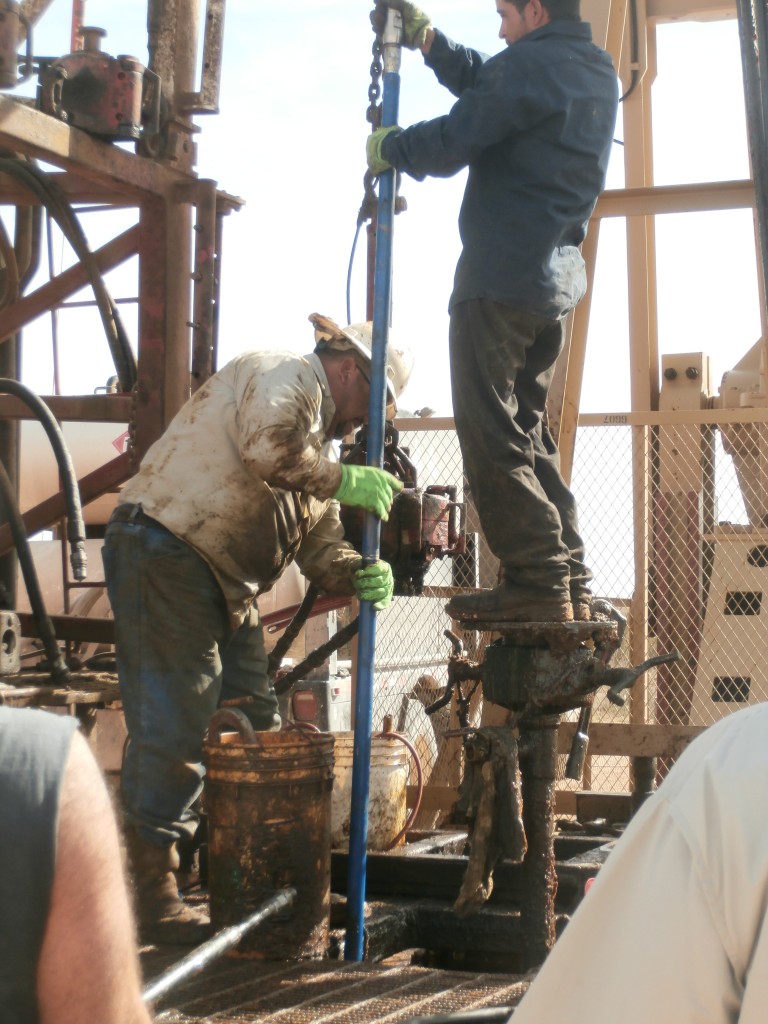Drill pipe, casing, and tubing are three kinds of pipe that go downhole. But there’s a world of pipe out there that runs laterally, parallel to the surface, either above it or just below it. Three companies share their expertise in the field of lateral oil transportation.
by Hanaba Munn Welch
Ups and downs come with the territory in the oil patch—literally and figuratively—from nodding pumpjacks to the price of crude charted on a graph. Sideways is the other direction. It’s the way oil moves once it’s produced: through flowlines, gathering lines, on trucks, by railcar, via pipelines—whatever it takes to deliver the product to the refinery.
The lateral movement of oil and gas is a segment of the industry that, in many cases, sees less fluctuation when booms turn to busts. In good times and bad, the oil keeps flowing and the gas keeps moving.
A look at three different types of companies tied to the movement of oil provides some insight into the effects of the market downturn on their operations, how they’ve survived, and where the Permian Basin fits in the whole scenario, plus one prediction for the future of the Permian.
The prediction is an upbeat one from Bryan Cossette, a spokesman for Fiberspar spoolable line pipe, a Houston-based company with a global presence.
In the case of Fiberspar, sales are mostly tied to new production. “Sales have been down because of the downturn in the market for the last couple of years,” Cossette said.
But the picture is not as gloomy in the Permian as elsewhere—at least not from Cossette’s vantage point. “The Permian region specifically has not only performed the best of all our North American regions during the downturn—it’s showing signs it’s going to be the first to rebound,” Cossette said. “During this downturn, even during the last two years, we’ve still installed pipe for 74 different venues in the Permian region, from the start of 2015 through the first half of 2016. The majority is for new production.”
One testimony to Fiberspar’s faith in the future of the Permian Basin is the company’s continuing presence in Midland. “We deploy pipe right in Midland,” Cossette said. “We keep an inventory of all the pipe and connections that we use. We have local employees. We like to be sure that we serve each market locally. We have an installation crew all living and working in the Midland-Odessa area.”
Fiberspar is part of San Antonio-based Fiber Glass Systems, a division of Houston-based National Oilwell Varco (NOV).
Fiberspar manufactures polyethylene flexible line pipe rated to withstand three differing temperatures—up to 140 degrees Fahrenheit, 180 degrees, and 203 degrees, respectively. The 203-degree pipe is Fiberspar’s newest line. “It’s really not in demand in the Permian,” Cossette said. “It’s more in demand for hotter production areas, such as California.”
A cross section of Fiberspar pipe reveals three layers, each with a different function. As explained by Cossette:
The inner thermoplastic lining—the bladder—determines the temperature rating of the pipe. The middle layer, glass-reinforced epoxy (GRE), determines the pressure rating. The outer layer is a “sacrificial” layer. “It’s not used for pressure containment,” Cossette said. “For long reels when you’re pulling it into a ditch across a surface, it takes the scratches and abrasions.”
It also shows off Fiberspar’s trademark color—a very bright green.
Polyethylene pipe, whether Fiberspar green or not, plays a role that traditionally has belonged to steel, not necessarily displacing steel but competing against it, and doing it well. “Our pipe is suitable for hydrocarbons, gas, CO2, injection water—anything that’s used in the oil and gas industry,” Cossette said.
And when existing steel pipes begin to fail, Fiberspar offers a remediation option that allows the old pipe to stay in place. “It’s called a freestanding rehabilitation liner,” Cossette said. “If the old steel is failing due to corrosion, rather than dealing with an entire new right of way, we can pull the Fiberspar right through that existing pipeline. That existing steel line is no longer needed for any sort of pressure. You have a new pipeline.”
It’s all about keeping the product moving efficiently.
Flo-Rite, a company based in Abilene, represents another approach to keeping the flow going at its best, both from the depths of the earth and at the surface level.
Flo-Rite manufactures a patented magnetic fluid conditioner (MFC) to reduce build-ups of paraffin and scale in oilfield piping and pumps. The company has seen its fortunes both hurt and helped by the drop in prices for crude. “We’ve actually seen a bit of a wash,” said Brandt Poulin, sales and marketing rep for Flo-Rite. “We’ve gotten some new customers during the downturn, and we’ve lost some old ones due to the downturn.”
Some of Flo-Rite’s clients had to shut in marginal wells or shut them down completely when oil prices took their drastic downslide. But other producers have turned to Flo-Rite in an effort to maximize their production to survive the current situation. “Now they’re looking to save money,” Poulin said. “Before, when the price of oil was high, it didn’t matter.”
Naturally, Flo-Rite would say it always matters.
Flo-Rite offers free trials to anyone interested in testing their MFC’s. Then, if the customer wants to keep the device, it’s not for sale. It’s for rent. “If it doesn’t work, they don’t pay for it,” Poulin said. “We stay with the customer and work with them… month to month.”
The stable rental income sustains Flo-Rite, as long as customers are pleased with the results of the product and the wells stay in production.
Flo-Rite’s story is an interesting one, both from the Russian origins of the technology to how the tool works—a physical phenomenon still not entirely understood but presented with formulas in the context of the physics on the Flo-Rite website, flo-ritefluids.com.
But for all producers, physics aside, the proof’s in the pudding, and Flo-Rite has pictures to show its MFC’s keep flow lines and other equipment from clogging with paraffin and scale buildup. “The tools treat paraffin, scale, and emulsion all in one, Poulin said.
It’s done with a tool that works without external power and can be installed downhole or above ground. Strong magnets do the trick.
The MFC technology has been around 40-to-50 years, Poulin said. “There have been a lot of bad products similar to ours,” he said.
Flo-Rite has worked toward perfecting the technology, patenting its redesigns and standing behind the tools via the free-trial and rental approach.
A plus is the ease of installation. “It’s basically a 30-second installation,” Poulin said, referring to the aboveground free trial offer.
When customers see how Flo-Rite’s tool works above ground to clean scale and paraffin from flow lines and to keep them flowing, the company expects the producer eventually to install the tool downhole. “We aren’t going to ask anybody to pull a well just to install our tool,” Poulin said.
But when the tool is installed downhole, it treats the produced fluid at the earliest point, reducing downhole flow problems.
Downhole, the Flo-Rite tools are installed right above the gas anchor or mud joint and surface units are placed at the well head and circulating pump. “Our standard tool sizes accommodate 2-3/8” and 2-7/8” tubing, 1-1/4” and 1-1/2” insert pumps, and 2” flowline,” Poulin said.
Flo-Rite is the manufacturer, enabling the company to offer customs sizes as well. The plant is at Clyde, near Abilene.
The Flo-Rite units are blue but otherwise look like ordinary lengths of pipe. Inside they contain magnets that create magnetic fields perpendicular to the flow of the fluid. The tools narrow the flow, thereby increasing the velocity. It’s the same technology that’s been in use for decades, but Flo-Rite claims to have discovered how to make it work best by paying attention to five essential considerations, listed in the company brochure as
⁃ Adequate magnetic strength
⁃ Number of magnetic poles
⁃ Sufficient fluid velocity through the MFC
⁃ Orthogonal application of the magnetic field to the flowing fluid
⁃ Stainless steel “outer tool”
In one sum-it-up sentence, Flo-Rite says what an MFC does:
“As the fluid passes through the magnetic fields the molecules of the paraffin and scale are affected in a way that prevent them from precipitating out of production and onto equipment.”
Flo-Rite has most of its unit in service in the Permian Basin. “We’re also in Kansas, Oklahoma, Louisiana, and down in the Eagle Ford,” Poulin said.
Flo-Rite holds three MFC patents and has one pending for an agricultural application.
In the Permian Basin, the network of lines that connects gathering systems to pipelines keeps growing, but moving oil isn’t all about lines. There’s still a need for tanker trucks to transport oil from some locations to pipeline stations. In areas where production is less, trucking is more the rule than the exception.
Transoil Marketing, L.L.C., buys and hauls oil. They’ve weathered some market fluctuations, including the current downturn. Based in Abilene, Transoil also has a yard at Midland on West Country Road 160, south of the airport.
First purchasers and gatherers, Transoil serves some big companies but also caters to smaller producers, independents included, buying and transporting crude oil. It’s a 40-truck company owned and managed jointly by Scot Martin and Robert Crabtree. “We focus on small-to-medium operators,” said Martin.
It’s a niche that tends to get overlooked by some of the bigger companies, Martin said.
Transoil has been hurt by the drop in prices for crude but not so much as to cause a reduction in their fleet or a significant change in their operations. “Our volumes are still hanging in,” Martin said.
At the peak of the recent boom, Transoil ran some extra trucks to handle the greater volume of oil—trucks hired rather than purchased. Now Transoil is running only one extra truck and that’s so primarily because the driver has turned out to be such a good hand. It’s the sort of decision that reflects the nature of the company—small enough to keep a third-party trucker working because they like his work ethic.
Neither Martin nor Crabtree thinks in terms of publicity. They’d rather talk about customer relations and how they stay in touch with the people they serve. Crabtree describes the Transoil service area in general terms as North Texas, West Texas, and Southeast New Mexico. “We strive to give our customers great service and competitive pricing,” Martin said. “We’re very hands-on.”
Like everyone else, Transoil has been negatively affected by the downturn in oil prices, but the company has maintained its stability. Not surprisingly, it’s the for-hire oil transport trucking companies that have been hurt the worst by the downslide in the price of crude. “The companies that sprang up in the boom with for-hire trucks, a lot have been parked,” Martin said.
At Transoil, it’s business as usual for Martin and Crabtree and it will be as long as there’s oil to buy and move, boom or bust.
Freelance writer Hanaba Munn Welch writes regularly for PBOG. She maintains a website at www.hanaba.net.














